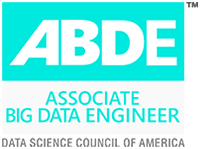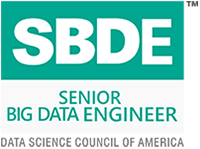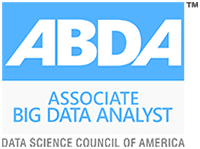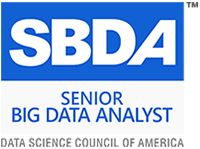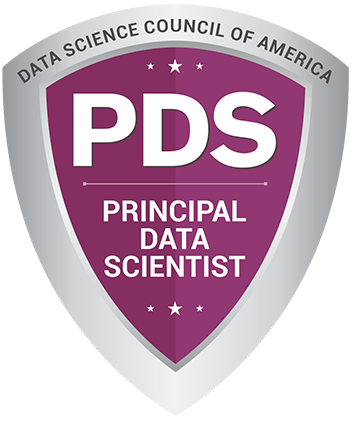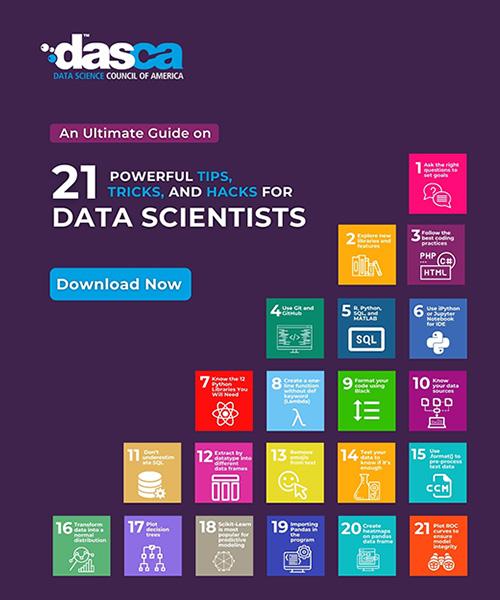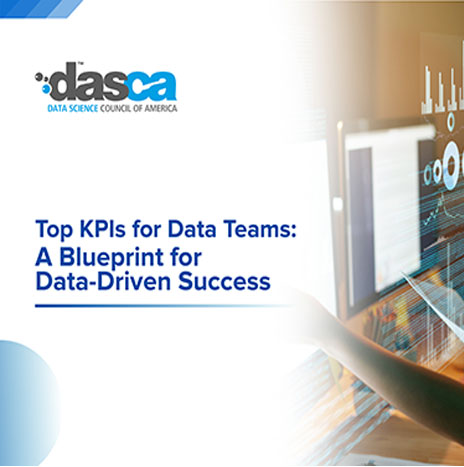
Modern businesses and industries depend heavily on prediction models to gain vital information while forecasting upcoming market trends in today's data-based economy. Analyzing historical data through data science predictive models assists organizations in achieving accurate outcome forecasts. Implementing predictive modeling methods that detect finance-related fraud and identify healthcare-related patient health risks results in strategic planning and efficiency improvements. Predictive models transform various industries because machine learning and AI programs produce innovations and help firms gain a competitive market position.
Core Concepts of Predictive Modeling
Predictive modeling is a statistical and machine learning concept that predicts future outcomes. It is widely used in all lines of business, including finance, healthcare, and marketing, and is very beneficial in both decision-making processes. Unlike historical methods of analyzing data, which seek to establish what has happened, a predictive model in data science presents what is likely to occur in the future, depending on the existing relations identified in the data.
Data Modeling:
- Data as the foundation: The data used to feed a model must be high-quality and relevant to feel accurate and clean. Pragmatic Institute Studies show that 80% of data science work entails data preparation.
- Statistical Analysis & Machine Learning: The statistical approach performs well when data is analyzed in two variables with a linear correlation. However, machine learning is much better at analyzing big data.
- Accuracy & Generalization: A model trained on the given training samples should also work correctly on real-world unknown samples. Two central problems concern the model's overfitting to the data (memorizing the data) and underfitting (not capturing the patterns).
- Model interpretability: Simple models, such as linear models, are easy to explain as compared to the deep learning model, which is accurate but very hard to explain what the model is doing.
Types of Predictive Modeling
Predictive modeling encompasses various techniques for finding valuable relationships between past and future events. These techniques fall into particular categories, that include classification, regression, time series, cluster, and deep learning models.
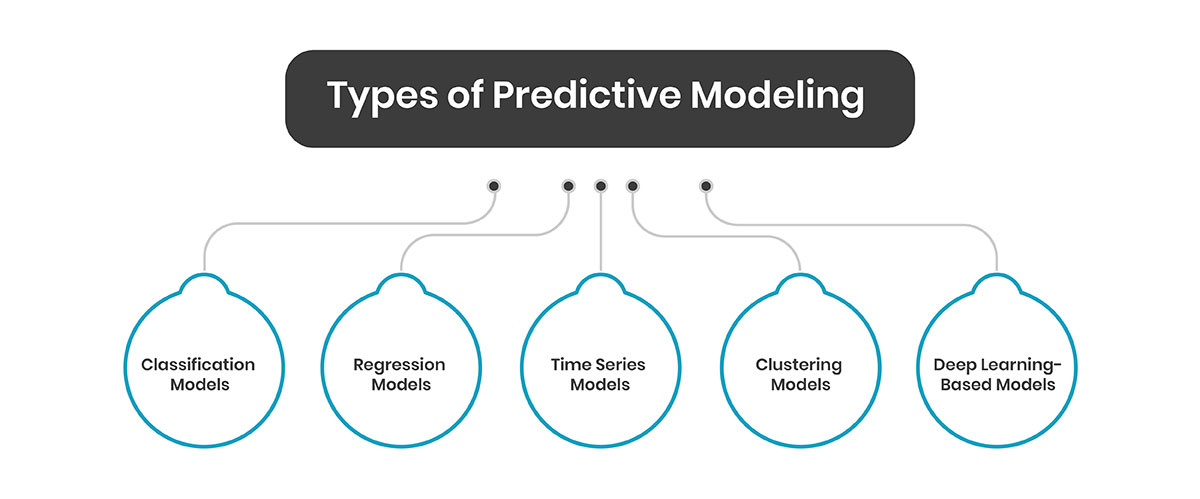
1. Classification Models
Classification models aim to determine when a result will be categorical, that is whether an email is spam. These models use labeled data, where the inputs are categorized and grouped into certain categories. They have applications in fraud detection, diagnosis of various diseases, and sentiment analysis.
- Standard Algorithms: Logistic Regression, Decision Trees, Random Forest.
- Example: A fraud detection system that uses the classification model to recognize fraudulent purchases will likely use past transaction data.
2. Regression Models
Regression models forecast continuous quantitative values, which makes them suitable for predicting amounts, rates, or values like traffic, sales, profits, etc. These models show the correlation between predictor and criterion variables.
- Standard Algorithms: Linear Regression, Ridge Regression, Lasso Regression.
- Example: Where annual sales of a product are forecasted based on previous figures obtained from sales revenue of the same product and other factors such as market trends.
3. Time Series Models
Time series modeling is a technique for predicting future values. It focuses on values taken over time and addresses trends and seasonal and cyclical factors that must be accommodated.
- Standard Algorithms: ARIMA, SARIMA, Prophet.
- Example: Weather forecasting models that determine changes in temperature use records of climatic information spanning several decades.
4. Clustering Models
Clustering models divide the data into un-predetermined categories. They are used in markets for market segmentation and anomaly detection.
- Standard Algorithms: K-Means, Hierarchical Clustering, DBSCAN.
- Example: Clustering is a business technique for grouping customers based on their behavior while purchasing goods and services. Retailers benefit from customizing their marketing strategies.
5. Deep Learning-Based Models
Deep learning networks are very effective in highly complex cases such as image recognition and natural language processing. These models can handle big data and operate on features that may be significantly large in number.
- Standard Algorithms: Recurrent Neural Networks (RNNs), Long Short-Term Memory (LSTM), Transformer Models.
- Example: Deep learning makes it easier for chatbots to mimic human responsibility, automating customer service.
Strategic Advantages of Predictive Modeling
Predictive modeling is also critical in modern data processing. It enables one to work with large amounts of data and extract meaningful information. Using historical data, business management can identify specific trends and improve the efficiency of their operations and the overall customer experience. Predictive modeling applies to many sectors, including finance, healthcare, marketing, and the supply chain.
Key Advantages include:
- Better decision-making: As per Global Trade, predictive modeling techniques can also reduce uncertainty in business strategies by up to 20%. Strategic management uses predictions to examine risks likely to affect various corporations and anticipate changes in market trends and demands.
- Risk Management and Fraud Detection: As per Feedzai reports, financial institutions also deploy analytics models in data science for real-time identification of fraudulent transactions with a fractionating of about 40%. Likewise, insurance industries also evaluate policies to avoid fraudulence using analytics.
- Enhanced Customer Experience: Consumer analysis can help businesses obtain better marketing results, which leads to more excellent customer retention and enhanced interaction. As per Folio3 studies, organizations that apply market targeting and segmentation through an analytical model have boosted revenues by 10 to 15 %.
- Operational Costs and Performance: ProHance reports say that predictive insights help minimize operational costs by as much as 23% in supply chain management, demand forecasting, and inventory optimization.
Essential Algorithms Used in Predictive Modeling
Predictive modeling algorithms can be divided into several groups, where each of the groups is adapted to fulfill certain types of predictive jobs:
1. Supervised Learning Algorithms
- Decision Trees: This approach subdivides data into branches to help make decisions. They are easy to understand and used for both numerical and non-numerical data. However, the disadvantage includes the fact that a large number of trees can lead to overfitting if not pruned.
- Random Forest: A technique where many decision trees are constructed, and their results are combined to increase accuracy and reduce machine learning error that occurs when a model is too closely aligned to training data, making it unable to accurately predict new data. It is suitable for big databases and can deal with thousands of input variables with little problem of variable deletion.
- Support Vector Machines (SVMs): Effective for high-dimensional spaces, SVMs are used for classification and regression by finding the hyperplane that best separates data into classes.
2. Unsupervised Learning Algorithms
- K-Means Clustering: An algorithm divides the data into ‘K’ clusters where the data points belonging to each cluster have maximum similarity. It is found applicable in cases of customer profiling and identification of trends.
- Principal Component Analysis (PCA): PCA is a technique that makes a large dataset manageable by reducing the number of features while retaining most of the variation in the process.
3. Ensemble Methods
- Gradient Boosting Machines (GBM): GBMs build models sequentially, each new model correcting errors from the previous one. This approach often results in high predictive accuracy but can be computationally intensive.
The Predictive Modeling Process: Step-by-Step Approach
Building a model in data science involves several essential steps to create a reliable model that can effectively solve a problem. These steps include obtaining the most accurate solution possible, and the final step is to use the designed model practically.
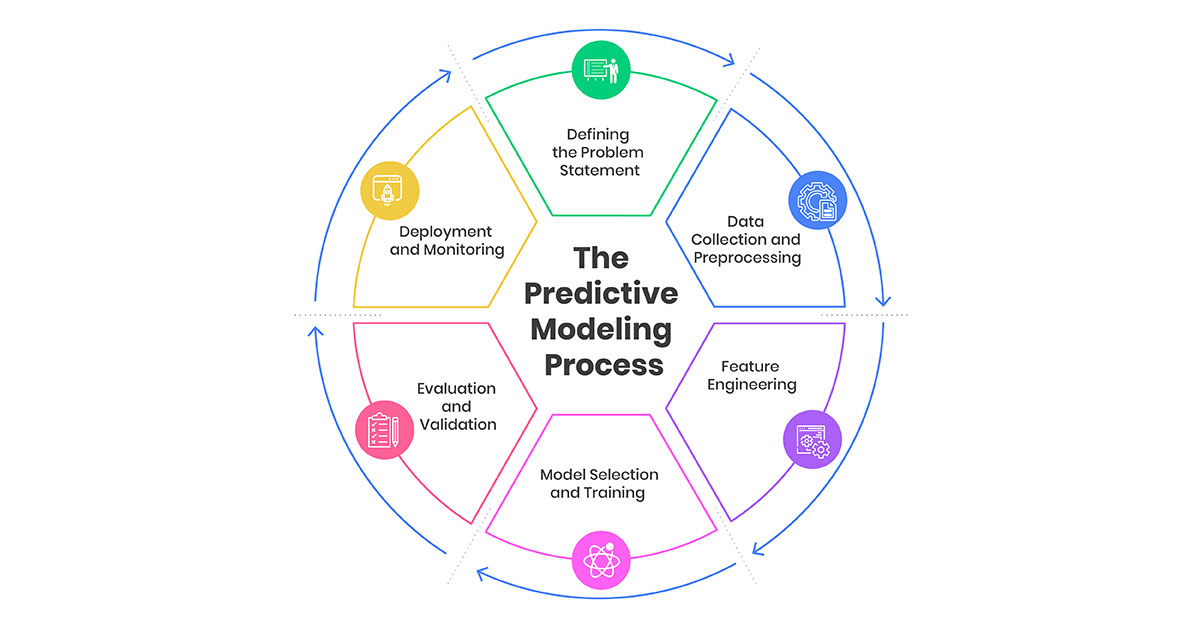
-
1. Defining the Problem Statement
The purpose must be explained and analyzed unambiguously, starting with the predictive modeling method. Whether the issue concerns customer churn, sales, or risk factors, a problem statement ensures the right approach and model selection. -
2. Data Collection and Preprocessing
Data is collected from different sources and should be significant and of good quality. The first steps in the preprocessing stage include handling the missing values, dealing with outliers, and ensuring data completeness to achieve proper predictive power. It is also statistically proven that bad data quality can lead to a decline in the quality of the model by as much as 50%. -
3. Feature Engineering
Develop additional variables or features likely to improve the model's performance. This step sometimes requires extensive familiarity with data to develop useful features that enhance the model’s prediction ability. -
4. Model Selection and Training
Select the ideal model depending on the problem category (classification, regression, etc.) and train the picked model using the provided data. This involves choosing the right algorithms which will suit the characteristics of the data gathered. -
5. Evaluation and Validation
Peculiar evaluation metrics that can be used to compare the model's performance including accuracy, precision, recall, Root Mean Square Error (RMSE), and R squared. Cross-validation also checks how much the model generalizes to new data. -
6. Deployment and Monitoring
The last step is to put this model into production if it has been tested and found to work as expected. This consists of constantly checking the model’s performance and ability to make correct predictions in the future while allowing new patterns to emerge.
Future Trends and Innovations in Predictive Modeling
Several trends are emerging regarding the future of predictive modeling, mainly related to artificial intelligence, automatization, and data connectivity. As organizations obtain more data, they require better and faster computation methods, such as predictive models, to improve decision-making and operations.
Key Trends Shaping Predictive Modeling
- AI-Augmented Predictive Models: Delivering deep learning integration and traditional approaches increases efficacy. It is well established that using AI in modeling increases forecast accuracy by up to 20%.
- Explainable AI (XAI): Account for the need for explanation as more regulation is placed on the models. XAI makes complex models easier for businesses to understand and use while keeping them legal and reliable.
- AutoML: As the name suggests, AutoML helps reduce the involvement of data scientists and includes model selection, hyperparameter tuning, and model deployment-related tasks in predictive analytics.
Conсlusion
Predictive modeling remains one of the key aspects of data science because it enables enterprises to reduce risks, make wiser decisions based on various tendencies, and improve customer satisfaction. Over time, using advanced predictive modeling techniques will become crucial for several industries. These models and new trends, such as AI-augmented techniques and real-time analytics, are expected to fuel innovation and sustain competitiveness in divergent fields.






